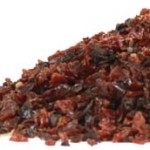 Rosehips have a tart flavor and can be used to make jelly, jam, soup or oil, or can be alternatively used to flavor tea. During World War II, the British government used collected rose hips to make rosehip syrup as a source of vitamin C to replace citrus fruits that were impossible to get. Rosehips have a long history of use in traditional medicine. Rosehip tea is a rich source of vitamin C, carrying all the benefits of that vitamin. In addition, the various flavonoids in rose hips have potent antioxidant action. Rose hips contain anti-inflammatory properties and may be used to support healthy joints.
Rosehips have a tart flavor and can be used to make jelly, jam, soup or oil, or can be alternatively used to flavor tea. During World War II, the British government used collected rose hips to make rosehip syrup as a source of vitamin C to replace citrus fruits that were impossible to get. Rosehips have a long history of use in traditional medicine. Rosehip tea is a rich source of vitamin C, carrying all the benefits of that vitamin. In addition, the various flavonoids in rose hips have potent antioxidant action. Rose hips contain anti-inflammatory properties and may be used to support healthy joints.
About Rosehips
Rosehips develop on wild roses as the flowers drop off. The rosehip, also called the rose haw, is actually the fruit of the rose. These fruits are one of the most concentrated sources of vitamin C available. The rosehips that come from the species Rosa Canina, are commonly referred to as the dog rose. These plants are deciduous shrubs native to Europe and western Asia. They typically grow between 1 and 5 meters in height, and possess attractive flowers which range in color from white to pink. The fruit, known as rose hips, appears in early summer, ripening throughout the season and into autumn.
Rosehips is also known as Rosa canina, Hip Berry, Rose Haws, Rose Heps, Wild Boar Fruit, Wild Rose and Dog Rose.
Constituents: Vitamins A, C, D, E, flavonoids, lycopene, iron.
Parts Used: Fruit either shelled or powdered.
Typical Preparations: Most commonly found in tea and liquors. Seldom found in capsule or extract form.
Precautions: None known.
